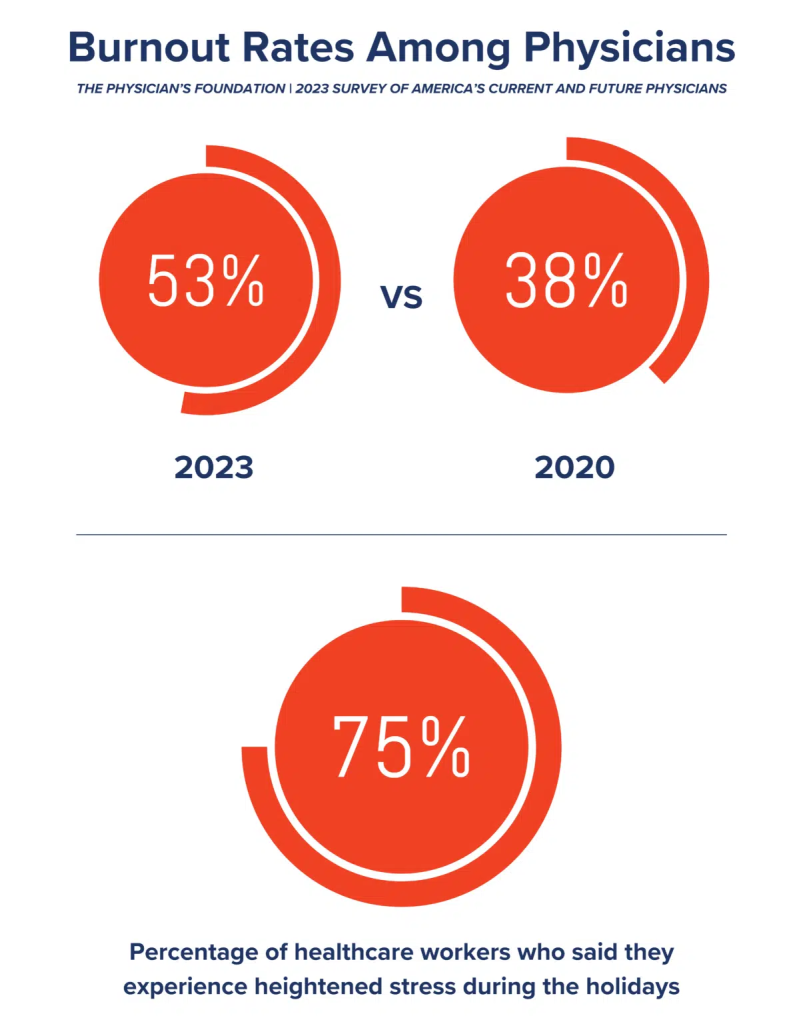The holiday season is often a time of joy and celebration, but for healthcare workers, it can also bring added stress, burnout, and safety concerns. From increased patient loads to heightened emotional demands, healthcare professionals face unique challenges during this time of year. Hospital executives and safety teams play a critical role in supporting these essential workers, ensuring both their mental health and physical safety during the holiday rush.
The Mental Health Impact of the Holidays
Healthcare workers already face significant mental health challenges, with a 2023 survey from the American Medical Association reporting that burnout rates among physicians reached 53%, up from 38% in 2020. The holiday season exacerbates this issue, as many healthcare providers work long hours, cover for colleagues on leave, and manage emotionally heavy cases often tied to end-of-year spikes in illness and accidents.
A recent report from the National Alliance on Mental Illness (NAMI) highlights that 75% of healthcare workers experience heightened stress during the holidays, with 62% reporting that this period negatively impacts their mental health. For nurses, who often serve as the backbone of patient care, the stress is particularly acute. A 2022 study found that 40% of nurses reported severe emotional exhaustion during the holiday period, largely due to understaffing and increased patient needs.
Workplace Violence: A Growing Concern Over the Holidays
In addition to mental health pressures, healthcare workers often face the risk of workplace violence—a risk that tends to spike over the holidays. According to the Occupational Safety and Health Administration (OSHA), healthcare workers are five times more likely to experience workplace violence compared to workers in other industries. These incidents range from verbal abuse to physical attacks, with emergency departments being particularly vulnerable. The impact of such violence on healthcare workers is profound, leading to higher rates of PTSD, anxiety, and depression. During the holiday season, this risk increases due to heightened emotions, overcrowded emergency rooms, and longer wait times.

Keeping Your People Safe During a Hectic and Stressful Holiday Season
In the midst of the holiday chaos, keeping healthcare workers safe—both physically and emotionally—should be a top priority. This requires a proactive and multipronged approach that addresses potential risks while fostering a culture of care and safety.
- Prioritize Psychological Safety
- Create an environment where healthcare workers feel comfortable reporting safety concerns or challenges without fear of repercussions.
- Encourage open communication between staff and leadership, ensuring workers feel heard and supported during high-stress periods.
- Provide regular check-ins with team members to assess their mental and emotional wellbeing.
- Strengthen Incident Response Systems
- Equip teams with panic buttons or mobile safety apps like SafeZone, which allow workers to quickly alert security in case of an emergency.
- Ensure all staff are aware of the hospital’s safety protocols and know how to use available tools for rapid response to incidents.
- Conduct holiday-specific safety drills to prepare for potential scenarios involving overcrowding or aggressive behavior.
- Foster Team Collaboration
- Promote teamwork by pairing more experienced staff with newer employees to handle challenging shifts together.
- Develop plans that allow team members to support one another during peak moments, preventing feelings of isolation or being overwhelmed.
- Celebrate small wins as a team, reinforcing a sense of unity and shared purpose.
- Make Security Visible and Accessible
- Increase the presence of security personnel in high-risk areas like emergency departments and waiting rooms.
- Place clear signage in public areas to deter aggressive behavior and reassure staff that their safety is a priority.
- Offer training in de-escalation techniques to help workers manage confrontational situations effectively and safely.
By implementing these measures, hospitals can create a safer, more supportive environment during one of the most demanding times of the year.
Actionable Strategies to Support Healthcare Workers
To address the challenges of mental health and workplace safety during the holidays, hospital executives and safety teams can implement practical strategies to support their teams:
- Adjust Scheduling to Prevent Burnout
- Ensure shifts are evenly distributed to avoid overloading individual staff members.
- Offer flexible scheduling options to allow workers time to relax and spend time with loved ones.
- Encourage teams to take short breaks during shifts, even when it’s busy.
- Provide Access to Wellness Programs
- Introduce mindfulness and stress-relief sessions.
- Partner with mental health professionals to provide on-site counseling or virtual support for employees during high-stress periods.
- Set up designated “quiet zones” in hospitals where staff can decompress during shifts.

- Enhance Workplace Safety Measures
- Increase security staff in high-risk areas, such as emergency departments, during the holiday season.
- Provide de-escalation training for healthcare workers to handle aggressive patient or family behavior.
- Use technology platforms like SafeZone for real-time safety alerts and quick access to security teams, ensuring workers feel protected.
- Recognize and Reward Staff
- Show appreciation through small gestures, such as holiday meals, gift cards, or handwritten thank-you notes.
- Host team-building activities or end-of-year celebrations to boost morale.
- Publicly acknowledge staff contributions, emphasizing their value to the organization.
Looking Ahead: Building a Culture of Support
The holiday season is a challenging time for healthcare teams, but with proactive planning and a commitment to employee wellbeing, hospitals can ensure their staff feel supported and safe. By addressing mental health needs, reducing burnout, and mitigating workplace violence risks, healthcare leaders can create a positive environment that allows workers to focus on what they do best: providing exceptional patient care.
As we move into the season of giving, let’s not forget to give back to the people who dedicate their lives to helping others. Supporting healthcare workers during the holidays isn’t just an investment in their wellbeing—it’s an investment in the quality of care they provide to our communities.








